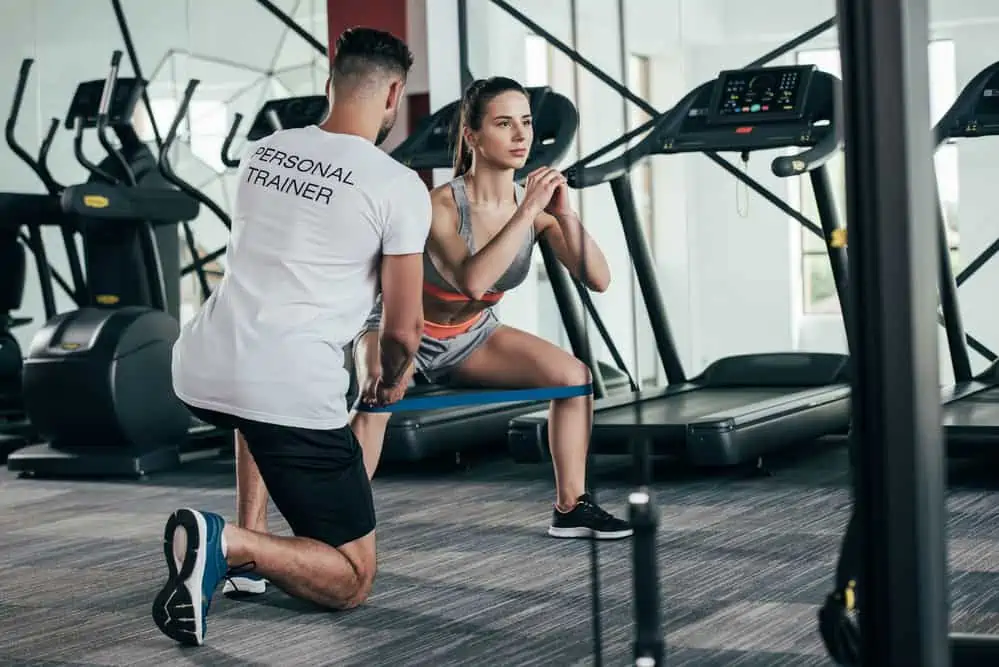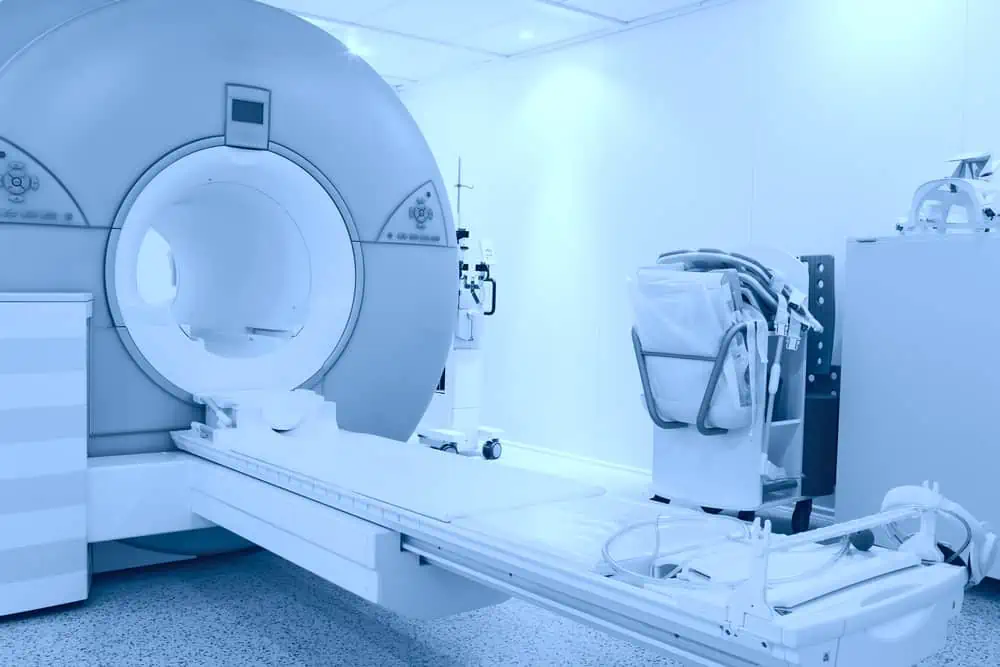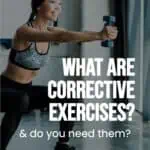This post may contain affiliate links. If you click through a link and make a purchase, I may receive a commission at no additional cost to you. As an Amazon Associate, I earn from qualifying purchases. Read the full disclosure here.
The fitness world is a hotbed for buzzwords – and the term “corrective exercise” is one of them.
Don’t get me wrong, corrective exercise can be extremely valuable when used appropriately. As usual, there’s a lot more information that needs to be teased out.
Let’s explore deeper into the topic of corrective exercise, plus how to tell if you need it and how to get it.
Disclaimer: This content is for educational purposes and is not medical advice. Read the full disclaimer.
What is corrective exercise?
We all move in everyday life. Whether we move well is another story.
If you’ve ever been to physical therapy, you’ve been evaluated and prescribed specific exercises to help you move better with less pain.
Even if you don’t have pain or discomfort, poor movement patterns can eventually lead to overuse injuries and movement issues.
Corrective exercise is a technique that combines knowledge of anatomy and biomechanics to address compensations and imbalances to improve your overall quality of movement. A skilled assessment considers how the body is moving as a whole and how one area can affect others throughout the kinetic chain, not just static posture.
It’s worth noting that the term “corrective exercise” doesn’t mean anything without a proper assessment. Corrective exercises are used to improve a specific movement dysfunction.
Corrective exercise can also be used by various trained healthcare and fitness professionals. The prescriber needs a strong anatomy and functional movement mechanics base to understand what they’re correcting.
This is precisely why you can’t just watch a “best corrective exercises” video.
The proper corrective exercises for you will differ from someone else, and they are based on your individual needs.
Any exercise or movement can be used as a corrective if needed. Corrective exercises can be a variety of stretching, flexibility, mobility, or strengthening exercises to target specific issues.
They’re not some top-secret set of special exercises.
Functional vs. corrective exercise
These two terms are often confused with each other, but aren’t the same.
A functional exercise is a compound movement aimed at improving specific motions required for a particular sport or movements in everyday life. Examples are squats, lunges, and step-ups. Exercise choices can differ based on activity-specific needs.
Functional training is yet a different concept and also includes aspects such as metabolic conditioning and high-intensity interval training in addition to strength exercises.
A corrective exercise aims to correct a specific dysfunction or limitation that’s preventing proper movement, for example, if someone’s knees are collapsing inward during a squat.
The goals behind why a particular exercise is selected is also different. For example, the same or similar exercise may serve as both a functional exercise or corrective exercise, but the focus or reasoning behind the choice will differ.
This quick 5-minute podcast does a great job at explaining the two, plus some other interesting facts.
Benefits of corrective exercise
- Improves mobility and movement patterns
- Improves posture, stability, and control of movements
- Improves strength balances between muscles in the body
- Decreases the risk for injuries and reduces unnecessary stress on the body
- Helps open up new exercise opportunities that may not have previously been available
- Bridges the gap between rehabilitation and return to fitness or sports activities
- Improves current mobility, fitness, or sports performance
What is muscle imbalance?
Muscle imbalance is one of those terms that’s also thrown around a lot. It’s a bit vague but seems to cover a lot of bases and makes it seem like someone knows what they’re talking about.
In short, muscles have opposing groups, for example, the quads and hamstrings. The quads extend the knee (straighten) and the hamstrings flex the knee (bend). When one muscle group is significantly stronger, weaker, or more restricted than the other, this affects movements.
Another example of musculoskeletal imbalances is frequently found in the upper torso between the chest and upper back. With all our time spent hunched over devices, this rounded posture takes a toll on the body and often leads to neck pain.
Muscle imbalances occur over time with poor posture habits and repetitive movement patterns.
One important thing to note about muscular imbalances is that massage therapy alone does not fix the underlying issue. If you just get a massage and go back to the same old bad habits, there won’t be any long-term carryover, and the pain will likely keep recurring.
To be clear, I think massages are wonderful and absolutely have a place in an overall health and wellness program. But in order to make changes, you need to reinforce good movement patterns by promoting mobility, strengthening, and flexibility.
Who can prescribe corrective exercises?
Physical therapists and other rehab professionals (such as chiropractors and athletic trainers) have been doing corrective exercises from a rehabilitation and injury prevention standpoint for years, even before the term became more mainstream.
From a fitness and performance standpoint, fitness professionals, personal trainers, professionals with a background in exercise science, kinesiology, and certain types of coaches can also become certified as corrective exercise specialists.
Remember, a proper assessment is the key to prescribing appropriate exercises based on individual needs and goals. The same corrective strategy doesn’t work for everyone.
If you have pain or discomfort, you should start with a physical therapist. Fitness professionals are not trained (nor allowed) to diagnose or treat injuries. This is not within their scope of work.
If you’re just curious about your movement or just feel like you’re stuck in your workout progression (but not limited by pain or an injury) you can see a personal trainer/fitness professional certified in corrective exercise.
Again, the usefulness of a corrective exercise depends on a proper assessment. If someone blindly says they’ll teach you a set of corrective exercises without looking at you, they’re just a random set of exercises.
Is corrective exercise the same as physical therapy?
No.
A physical therapist may evaluate and provide corrective exercises, but a corrective exercise specialist is not a physical therapist (unless they also happen to be a licensed physical therapist).
While there are some parallels between these two, it’s important not to confuse the role of each professional.
Physical therapists are licensed health care professionals who diagnose and treat various medical conditions to help patients move and function better.
Evaluating movement and prescribing therapeutic exercise is one part of physical therapy treatment. Other areas may include manual therapy, therapeutic modalities, and patient education, depending on the specific needs of the patient.
A corrective exercise specialist is not trained to diagnose or treat any medical conditions (and should never lead clients to believe that they are – unless they also happen to be a health care provider and are working in that capacity.)
Corrective exercise specialists evaluate movement patterns for imbalances, restrictions, and other dysfunctions that affect someone’s ability to exercise or move well from a fitness standpoint.
Seeing a corrective exercise specialist after discharge from physical therapy is a great way to bridge the gap between rehabilitation and a healthy exercise program.
This article does a nice job of breaking down more differences between physical therapy and corrective exercise.
Does everyone need corrective exercises?
No. (Not all the time at least.)
Corrective exercises are popular now, which means people tend to go overboard on their uses.
In reality, corrective exercises are only useful if there’s something to correct, and some of them don’t need to be a lifelong commitment.
If an exercise is genuinely corrective, there will be a significant improvement quickly.
You also shouldn’t be dedicating your entire workout to “correctives.”
Getting the most out of your corrective exercises
A corrective exercise program should focus on the root cause of the dysfunction, not just the compensatory movement.
An example of this might be the knee collapsing inward with a squat or lunge. While we’re seeing an inward motion at the knee, the issue may be coming from a weakness in the hips or the quads.
Continuing with this poor movement pattern can lead to IT band syndrome or patellofemoral pain. Focusing further attention on the assessment of hip mobility and strength combined with exercises that bring awareness to the alignment of the knee may be appropriate.
Alignment is how joints and soft tissues stack up and move in relation to each other. Good alignment helps transfer force throughout the body for proper movement patterns and helps prevent injuries.
For a corrective exercise to be effective, you need to pay attention to your alignment and form. Doing corrective exercises with poor technique is a waste of time.
That being said, proper alignment may look slightly different in different bodies due to natural variations in anatomy, such as joint structure. Two people can perform the same exercise, both be appropriately aligned, and still look different.
Wrapping up
Corrective exercises are a very useful technique to improve movement patterns to optimize motion and decrease your risk of injuries.
Avoid guessing or wasting time with the wrong exercises and get an assessment. A proper assessment by a trained professional is key to getting the right exercises for you.
Working with different professionals at various stages of rehab and fitness helps provide a well-rounded approach to good movement and injury prevention.
References
Bagherian, Sajad MSc; Rahnama, Nader PhD; Wikstrom, Erik A. PhD, ATC† Corrective Exercises Improve Movement Efficiency and Sensorimotor Function but Not Fatigue Sensitivity in Chronic Ankle Instability Patients: A Randomized Controlled Trial, Clinical Journal of Sport Medicine: May 2019 – Volume 29 – Issue 3 – p 193-202
doi: 10.1097/JSM.0000000000000511
Bayattork, M., Seidi, F., Minoonejad, H. et al. The effectiveness of a comprehensive corrective exercises program and subsequent detraining on alignment, muscle activation, and movement pattern in men with upper crossed syndrome: protocol for a parallel-group randomized controlled trial. Trials 21, 255 (2020). https://doi.org/10.1186/s13063-020-4159-9






